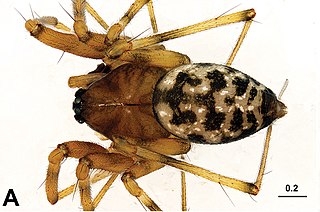 W
WAcanoides is a genus of sheet weavers first described in 2014. As of February 2019, it contains only two species, both in China.
 W
WAcanthoneta is a genus of sheet weavers first described by Eskov & Marusik in 1992. As of February 2019, it contains only three species, found in China, Russia, and North America
 W
WAllagelena opulenta is a species of funnel weaver spider of the family Agelenidae. The species was first described by Ludwig Carl Christian Koch in 1878.
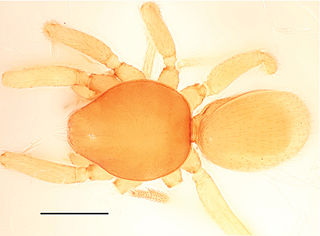 W
WBannana is a genus of goblin spiders native to Xishuangbanna prefecture, Yunnan Province, China, where it lives in the leaf-litter of tropical rainforest. There are two known species: Bannana crassispina and B. parvula, both described in 2015. Individuals are pale yellow and unpatterned, and range from around 1.0 to 1.8 mm in body length, with females being slightly larger than males. The eyes are reduced or entirely absent. Known only from a nature reserve in Xishuangbanna, Bannana belongs to a group of Asian goblin spiders known as the "Dysderoides complex", that ranges from China to Pakistan and south to Indonesia.
 W
WCraspedisia is a genus of comb-footed spiders that was first described by Eugène Louis Simon in 1894. As of May 2020 it contains three species, found in China, the Dominican Republic, and Brazil: C. cornuta, C. longioembolia, and C. spatulata.
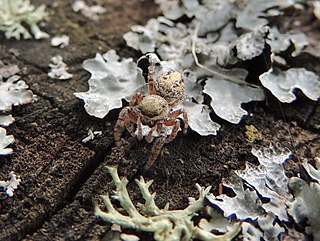 W
WDendryphantes elgonensis is a jumping spider species in the genus Dendryphantes that lives in the Palearctic.
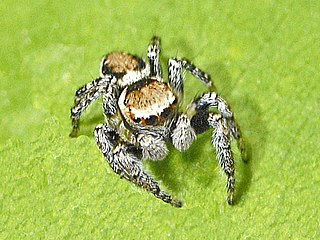 W
WEvarcha falcata is a species of 'jumping spiders' belonging to the family Salticidae.
 W
WFlexicrurum is a genus of spiders from China similar to the genera Althepus and Leclercera. Tong and Li originally placed the genus in Ochyroceratidae, but Tong later moved it to Psilodercidae. Males are generally smaller than 2 mm, but the size of females is unknown. The name is derived from Latin flex "curved", and crur "leg", referring to the inner turned palpal tibia of the male. As of 2019 three described species have been found in caves of Hainan Island.
 W
WFrontinella is a genus of dwarf spiders that was first described by Frederick Octavius Pickard-Cambridge in 1902.
 W
WGongylidium is a genus of sheet weavers that was first described by Anton Menge in 1868. As of April 2020 it contains three species, found in Asia and Europe: G. baltoroi, G. rufipes, and G. soror.
 W
WHelophora is a genus of dwarf spiders that was first described by Anton Menge in 1866.
 W
WIndoxysticus is a genus of Asian crab spiders that was first described by S. P. Benjamin & Z. Jaleel in 2010. As of September 2020 it contains three species, all found in Asia: I. lumbricus, I. minutus, and I. tangi. The genus differs from others in its family by the oval-shaped spermathecae with well-defined chambers in females and by the broad-based embolus in males.
 W
WLampshade spiders, family Hypochilidae, are among the most primitive of araneomorph spiders. There are two genera and twelve species currently recognized. Like mygalomorphs, most hypochilids have two pairs of book lungs, but like araneomorphs they have intersecting fangs, with the exception of some species which have chelicerae in an angle that is neither orthognathous or labidognathous. These long-legged spiders build typical "lampshade" style webs under overhangs and in caves. In the United States the fauna is primarily associated with the Appalachian, Rocky and California Mountains. Ten of the known species are found in these ranges, all in the genus Hypochilus. The genus Ectatosticta is found in China.
 W
WLariniaria is a genus of Asian orb-weaver spiders containing the single species, Lariniaria argiopiformis. It was first described by M. Grasshoff in 1970, and has only been found in Russia, China, Korea, and Japan.
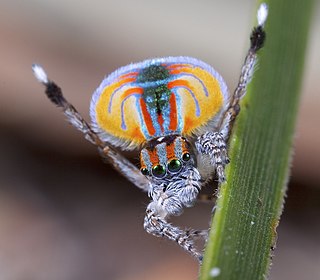 W
WMaratus is a spider genus of the family Salticidae. These spiders are commonly referred to as peacock spiders due to the males' colorful and usually iridescent patterns on the upper surface of the abdomen often enhanced with lateral flaps or bristles, which they display during courtship. Females lack these bright colors, being cryptic in appearance. In at least one species, Maratus vespertilio, the expansion of the flaps also occurs during ritualised contests between males. The male display and courtship dance are complex, involving visual and vibratory signals.
 W
WMoebelia is a genus of dwarf spiders that was first described by Friedrich Dahl in 1886. As of May 2019 it contains only three species, found in China, Germany, and Russia: M. berolinensis, M. penicillata, and M. rectangula.
 W
WMysmena wawuensis is a species of spider found in China. It grows to 0.75 millimetres long. It is named after the Wawu Mountain National Forest Park in Sichuan Province in southwestern China where it was discovered and first described in 2013 by Yucheng Lin and Shuqiang Li. It was collected from the leaf litter at an altitude of 1,929 metres (6,329 ft) and is only known from the type locality.
 W
WOxyopes shweta is a species of lynx spider. This spider is distributed in India and China.
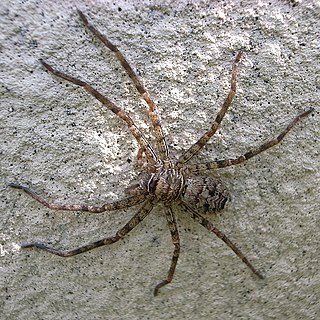 W
WSinopoda forcipata is a species of spider in the family Sparassidae. It was described by Ferdinand Karsch in 1881.
 W
WSpiricoelotes is a genus of East Asian funnel weavers first described by X. P. Wang in 2002.
 W
WThomisops is a genus of spiders in the family Thomisidae. It was first described in 1879 by Karsch. As of 2017, it contains 10 species from China and Africa.
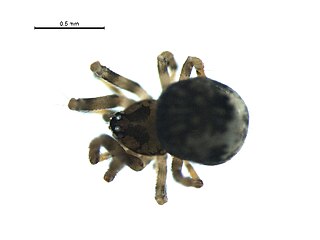 W
WTrogloneta is a genus of spurred orb-weavers that was first described by Eugène Louis Simon in 1922.